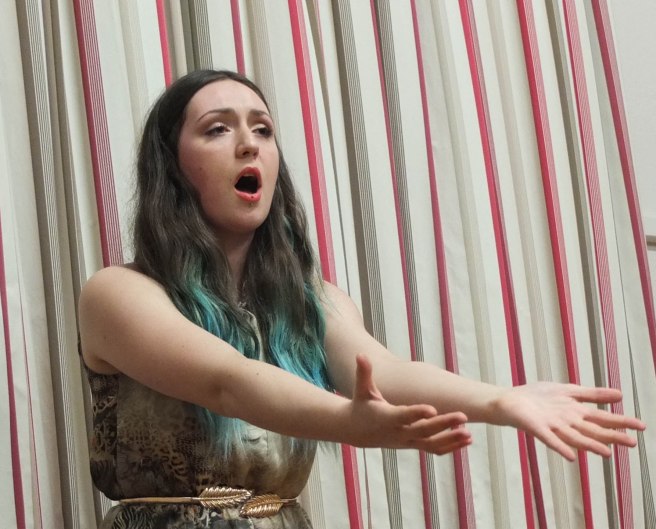By EL Putnam
A body appears, made androgynous by the covering of a black, biomorph suit. This body walks with purpose to the middle of the road carrying the mask of a horse’s head and candles atop yellow and black striped sticks. Though his body and expressions are obscured, his posture denotes a resoluteness. Cars and buses continue to drive by, occasionally slowing to catch a glimpse at the unusual sight, perhaps out of curiosity or annoyance at the break from routine behaviours. The audience collects on the sidewalk, forming a mass of witnesses, enraptured by the danger building as Jelili Atiku stands between the two lanes of traffic — an intervention into the mundane. When Atiku returns to the gallery, he picks up a small teddy bear. Purchased from a local charity shop, as evidenced by the price tag still attached, he walks through the audience, showing each individual this bastardised memento while handling it with the reverence due to a relic. He repeats the process with a second teddy bear, attaching both to the wall. His body between them form an index of a crucifixion to consumerism.

This performance, Agurmenta Dialogorum (What did I buy from you?), constitutes a series of rituals, blending gestures of spiritual reverence with elements of neoliberal existence. Transformation is a prominent theme throughout the work. As Atiku wraps his body in yellow and black striped tape, he undertakes a process of metamorphosis from a human form to a monstrous being. Winding the tape around his legs and torso, he inserts candles that create spines along his corporeal curves. The task is slow and methodical; a proprioceptive transformation that not only shifts how he moves through space, but how others relate to him. At some points, he grabs the nostrils of the horse mask that he wears, indicating difficulty breathing, though these perceived physical tensions do not deter him from his actions. He does not perform for his audience, but engages their presence, asking for them to light the candles that decorate his body using unique drawings, each of which request the individual recipient to “Kindly Light the Candles.” This gesture of hospitality warms the crowd. As he becomes a human candelabra, people grasp the long matches, seeking out wicks in need of light. We engage in a unorchestrated dance, making Atiku’s body burn brighter. The wax drips at odd angles, taking on a seminal quality in its inability to resist gravity. Atiku then returns his body to a state of self, shedding the burning candles, the tape that had become a second skin, and finally the black, biomorph suit.

Throughout this event, Atiku creates a scenario of danger and beauty, where everyday items become the impetus for sculptural actions. The performance challenges the limits of safety, but without pushing the body over the threshold of harm. As an artist, Atiku utilises what German theatre scholar Erika Fischer-Lichte refers to as the transformative power of performance — where simple materials, mundane spaces, the human body, and our relations to each other are metamorphosised through actions. The intentions motivating these actions may not always be clear as the work unfolds, but such is the appeal of this medium that sits at the cross-section of different forms of expression. Existence as we take it for granted is made strange through the performance encounter. Even though these experiences are ephemeral, they alter us as we re-enter the ongoing stream of life. While Atiku undergoes a visual and spatial metamorphosis through his ritual gestures, he is also changing us witnesses through the staging of this encounter. What each witness takes from this experience may vary — I considered my interactions as an American with a Nigerian in Ireland encompass the sort of cultural reciprocity encouraged by neoliberalism. The subtitle of the work, What did I buy from you?, supports this interpretation. Just as neoliberalism as opened up channels of travel and exchange around the globe, making the world appear more open and brighter, there is a nefarious underside to this ideology. Despite impressions of new freedoms and broader horizons, there is the risk of being shackled by these privileges as we are increasingly indebted to omnipotent and ineffable creditors; the more we consume, the more we contribute to the system that provides for and entraps us. The price of compliance is financial, but also environmental, ethical, and human. Atiku’s use of tape to hold up candles we light while simultaneously binding the body provides an apt metaphor for this tension. At the same time, actions have mutual reactions — we collectively contribute to the production of a scene that entangles us. Atiku’s performance raises the question: is it possible to escape the binds of the system with our bare bodies and humanity in tact?

Jelili Atiku presented Argumenta Dialogorum (What did I buy from you?) at the 2016 Dublin Live Art Festival, curated by Niámh Murphy at Mart Gallery in Rathmines. Photos by Blueprint Photography.





